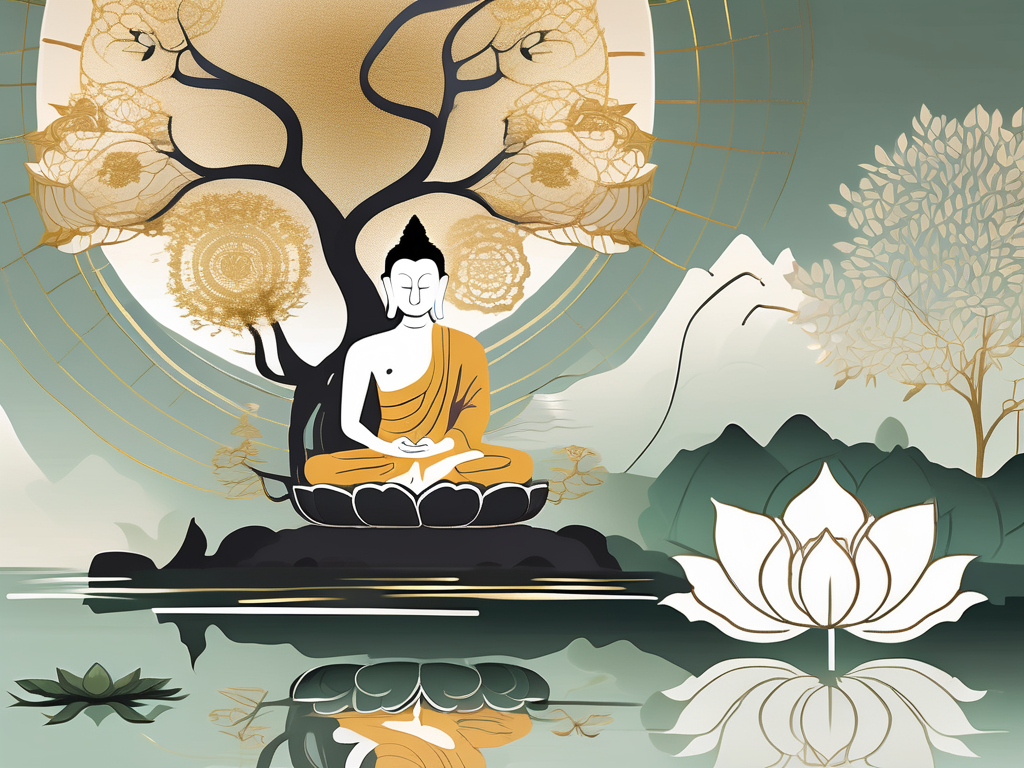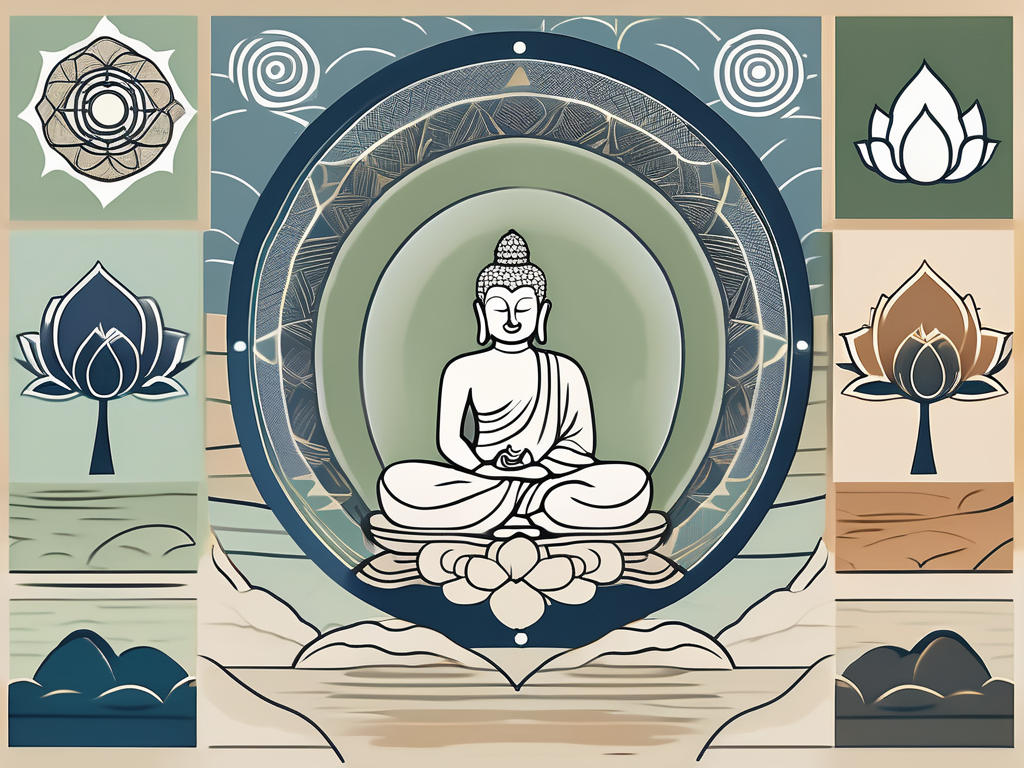Welcome on a journey to explore the origins of Mahayana Buddhism. In this article, we will delve into the rich history and philosophical foundations of Mahayana, uncovering its core principles, tracing its roots, and examining its spread across Asia. We will also explore the practices and rituals that Mahayana followers engage in to attain enlightenment. So, let’s embark on this enlightening adventure together!
Understanding Mahayana: A Brief Overview
Mahayana, meaning “Great Vehicle” in Sanskrit, is one of the two main branches of Buddhism, the other being Theravada. While Theravada focuses on individual liberation, Mahayana emphasizes the liberation and enlightenment of all sentient beings. Its core principles and teachings provide a path for compassion, wisdom, and the attainment of Buddhahood.
One of the key concepts in Mahayana is the Bodhisattva ideal, which guides followers to work towards the liberation of all beings. This selfless commitment to alleviating suffering sets Mahayana apart from other Buddhist traditions.
Mahayana Buddhism originated in India and spread to various parts of Asia, including China, Japan, Korea, and Tibet. As it traveled across different cultures, Mahayana absorbed local beliefs and practices, resulting in diverse expressions of the tradition.
The Mahayana scriptures, known as sutras, are vast and encompass a wide range of teachings. These texts serve as a source of inspiration and guidance for Mahayana practitioners, offering profound insights into the nature of reality and the path to enlightenment.
The Core Principles of Mahayana Buddhism
At the heart of Mahayana Buddhism lie the Four Noble Truths and the Eightfold Path, principles shared with Theravada Buddhism. However, Mahayana expands on these foundational teachings with its concepts of Sunyata (Emptiness) and the Bodhisattva ideal.
Sunyata, the concept of emptiness, emphasizes that all phenomena lack inherent existence. It encourages practitioners to transcend dualistic thinking and perceive the interconnectedness and interdependence of all things. Through this understanding, practitioners can realize the ultimate nature of reality and achieve liberation.
The Bodhisattva ideal expresses the aspiration to become a Bodhisattva, a being dedicated to attaining enlightenment for the benefit of all sentient beings. Bodhisattvas renounce personal enlightenment until all beings have attained liberation. This altruistic goal drives Mahayana practitioners to cultivate compassion, wisdom, and skillful means to guide others on their path to salvation.
In addition to Sunyata and the Bodhisattva ideal, Mahayana also emphasizes the practice of meditation as a means to develop mindfulness, concentration, and insight. Meditation allows practitioners to deepen their understanding of the nature of reality and cultivate inner peace and clarity.
The Role of Mahayana in Modern Buddhism
In modern Buddhism, Mahayana has played a pivotal role in shaping the religion’s development and spreading its teachings across the world. The influence of Mahayana can be witnessed in various Buddhist traditions, including Zen, Pure Land, and Tibetan Buddhism.
Mahayana’s emphasis on compassion and the ideal of the Bodhisattva has resonated with many seekers, as it provides a path to spiritual growth while actively engaging with societal well-being. Its teachings continue to inspire and guide countless individuals on their quest for enlightenment in today’s fast-paced world.
As Mahayana Buddhism continues to evolve and adapt to the modern context, it remains a vibrant and dynamic tradition, offering profound insights and practices for those seeking spiritual awakening and the alleviation of suffering.
Through its teachings and practices, Mahayana Buddhism invites individuals to embark on a transformative journey of self-discovery, compassion, and wisdom. It encourages practitioners to cultivate a deep sense of interconnectedness with all beings and to actively contribute to the well-being of the world.
Whether through meditation, study of sacred texts, or engagement in acts of kindness and service, Mahayana provides a rich and diverse path for individuals to explore their true nature and contribute to the betterment of society.
Tracing the Roots of Mahayana
To understand Mahayana’s development, we need to explore its historical context and discover the key figures and texts that contributed to its emergence.
Mahayana Buddhism, one of the major branches of Buddhism, emerged around the 1st century CE in India, during a period of dramatic social and religious change. This was a time when various philosophical and cultural currents were converging, creating fertile ground for the birth of new ideas and perspectives. It was within this dynamic environment that Mahayana offered a fresh and innovative approach to the path of liberation.
During this period, Buddhism faced criticism from both within and outside its community. Some criticized the religion for its elaborate monastic practices, which seemed inaccessible and detached from the lives of ordinary people. Lay practitioners, who were unable to fully engage with the traditional path, sought a more inclusive and practical approach to Buddhism. Mahayana, with its emphasis on the universal potential for awakening and its accessibility to all, addressed these concerns and appealed to a broader audience.
The Emergence of Mahayana: Historical Context
Mahayana Buddhism emerged as a response to the changing needs and aspirations of Buddhist practitioners. It offered a new vision of the path to enlightenment, one that emphasized compassion, wisdom, and the interconnectedness of all beings. This shift in focus allowed Mahayana to transcend the limitations of the traditional Theravada Buddhism and offer a more expansive and inclusive spiritual path.
Key to the emergence of Mahayana was the recognition that the path to liberation was not limited to renunciants and monastics. Lay practitioners, with their worldly responsibilities and commitments, could also attain enlightenment. This idea challenged the prevailing notion that only those who renounced the world could achieve spiritual liberation.
Furthermore, Mahayana sought to address the growing disillusionment with the existing Buddhist teachings. While the core teachings of the Buddha remained central, Mahayana introduced new concepts and practices that resonated with the changing times. It presented a radical reinterpretation of the Buddha’s teachings, emphasizing the importance of compassion, wisdom, and the cultivation of bodhisattva ideals.
Key Figures and Texts in Early Mahayana
Early Mahayana was shaped by influential figures who played a crucial role in the development and propagation of its teachings. Among these luminaries were Nagarjuna, Asanga, and Vasubandhu, whose philosophical works laid the foundation for Mahayana thought.
Nagarjuna, in particular, made significant contributions to Mahayana philosophy through his writings on Sunyata (emptiness) and the Middle Way. His profound insights into the nature of reality and the interconnectedness of all phenomena had a lasting impact on Mahayana thought. Nagarjuna emphasized the importance of transcending extremes and realizing the intricate and interdependent nature of existence.
In addition to the influential figures, Mahayana drew inspiration from a diverse collection of scriptures known as sutras. These sutras, such as the Lotus Sutra and the Heart Sutra, presented profound teachings on compassion, wisdom, and the nature of reality. They became essential texts for Mahayana practitioners, guiding them on the path to enlightenment and serving as a source of inspiration and contemplation.
The Lotus Sutra, for instance, expounded on the concept of skillful means (upaya) and the universal potential for awakening. It emphasized the idea that all beings possess the innate capacity to become buddhas and that the path to enlightenment is open to everyone, regardless of their background or circumstances.
The Heart Sutra, on the other hand, delved into the profound wisdom of emptiness (Sunyata) and the interdependence of all phenomena. It offered a concise yet profound insight into the nature of reality, challenging conventional notions of existence and pointing to the ultimate truth beyond concepts and dualities.
These texts, along with many others, continue to be revered and studied by Mahayana practitioners around the world. They serve as a source of guidance, inspiration, and contemplation, inviting practitioners to deepen their understanding and realization of the Mahayana path.
The Philosophical Foundations of Mahayana
Mahayana Buddhism rests on philosophical principles that provide a framework for understanding reality and the path to enlightenment.
The origins of Mahayana can be traced back to the early centuries of the Common Era, when Buddhism began to expand beyond its birthplace in India. As it spread to other regions, such as China, Tibet, and Japan, it underwent significant transformations, both in terms of its practices and philosophical outlook.
One of the key philosophical concepts in Mahayana is the notion of Sunyata, often translated as “emptiness.” This concept challenges our conventional understanding of existence and asserts that all phenomena lack inherent, independent existence. Instead, reality is seen as interconnected and arises dependently upon causes and conditions.
Within the framework of Sunyata, Mahayana practitioners explore the nature of reality and the self. They delve into the profound question of what it means to exist and how our perceptions shape our understanding of the world. By realizing the empty nature of phenomena, practitioners can untangle themselves from delusions and false perceptions, ultimately leading to a deeper understanding of reality.
But what does it mean to realize emptiness? It is not a mere intellectual exercise or a philosophical concept to be grasped. Rather, it is a transformative experience that goes beyond words and concepts. It is a direct, experiential realization that can profoundly shift one’s perspective and lead to a profound sense of freedom.
The Concept of Sunyata (Emptiness) in Mahayana
Sunyata, the central concept in Mahayana, challenges our conventional understanding of existence. It asserts that all phenomena lack inherent, independent existence. Instead, reality is interconnected and arises dependently upon causes and conditions.
When we contemplate the emptiness of phenomena, we begin to see the interdependent nature of all things. We realize that nothing exists in isolation, but rather everything is connected in a vast web of relationships. This understanding can have profound implications for how we relate to ourselves, others, and the world around us.
Imagine a spider weaving its intricate web. Each strand is connected to the others, forming a delicate and interconnected structure. In the same way, all phenomena are interconnected, each dependent on the others for its existence. Just as pulling one strand of the spider’s web affects the entire structure, our actions and thoughts have far-reaching consequences in the interconnected web of reality.
By realizing the empty nature of phenomena, practitioners can untangle themselves from delusions and false perceptions. This awakened understanding opens the path to liberation and the realization of our interconnectedness with all beings.
Emptiness is not a nihilistic view that denies the existence of anything. Rather, it is a profound insight into the nature of reality that transcends our ordinary dualistic thinking. It is a recognition that things are not as solid and fixed as they appear, and that our perceptions are shaped by our own mental constructs.
The Bodhisattva Ideal and the Path to Enlightenment
The Bodhisattva ideal lies at the heart of Mahayana practice, offering a compassionate and altruistic approach to enlightenment. Bodhisattvas devote themselves to the welfare of all beings and commit to guiding them towards liberation.
The path of the Bodhisattva involves cultivating compassion, wisdom, and the practice of the Six Paramitas (perfections): generosity, ethical conduct, patience, joyful effort, concentration, and wisdom. These qualities are not seen as separate or isolated, but rather as interconnected and mutually supportive.
Imagine a Bodhisattva as a compassionate gardener tending to a garden. They cultivate the soil of their own mind, removing the weeds of ignorance and planting the seeds of wisdom and compassion. They water the garden with acts of generosity and ethical conduct, nurturing the growth of positive qualities. They patiently tend to the garden, knowing that the fruits of their efforts may take time to ripen.
By embodying these qualities, Bodhisattvas aspire to liberate all beings from the cycle of suffering. They see the interconnectedness of all beings and recognize that their own liberation is intimately tied to the liberation of others. This selfless dedication to the welfare of all beings is the essence of the Bodhisattva ideal.
It is important to note that the path of the Bodhisattva is not an easy one. It requires great courage, perseverance, and a deep commitment to the well-being of others. It is a path that challenges our self-centered tendencies and invites us to expand our circle of compassion to include all beings.
As we walk the path of the Bodhisattva, we may stumble and fall, but we rise again with renewed determination. We learn from our mistakes and continue to cultivate the qualities of compassion and wisdom. In doing so, we contribute to the well-being of others and create the conditions for our own liberation.
The Spread of Mahayana Across Asia
As Mahayana Buddhism flourished, it began to spread across different regions of Asia, notably China, Japan, and Korea.
Mahayana Buddhism in China
When Mahayana reached China, it encountered existing religious and philosophical traditions, leading to a fascinating interplay of ideas. The influence of Mahayana can be observed in various Chinese Buddhist schools, including Pure Land, Chan (Zen), and Tiantai.
China’s history of religious syncretism allowed Mahayana to adapt and integrate with Taoist and Confucian beliefs, resulting in unique expressions of Buddhism in the country.
The Influence of Mahayana in Japan and Korea
From China, Mahayana Buddhism also spread to Japan and Korea, impacting the religious landscapes of both countries.
In Japan, Mahayana took root in the forms of Pure Land Buddhism, Zen Buddhism, and Nichiren Buddhism. Each school brought its distinct practices and teachings, allowing followers to find enlightenment through different paths.
In Korea, Mahayana Buddhism merged with indigenous traditions, giving rise to the Korean Seon (Zen) tradition. This fusion of philosophies continues to shape the practice of Buddhism in Korea.
The Practices and Rituals of Mahayana
Mahayana Buddhism encompasses a rich array of practices and rituals that support the journey towards enlightenment.
Meditation and Mindfulness in Mahayana
Meditation plays a significant role in Mahayana practice, facilitating the cultivation of mindfulness and facilitating direct insight into the nature of reality. Various meditation techniques, such as Shamatha (calm abiding) and Vipassana (insight), guide practitioners towards a deeper understanding of themselves and the world around them.
Mindfulness practices encourage practitioners to be fully present and aware, fostering a compassionate and non-judgmental mindset towards themselves and others. Through sustained practice, individuals develop clarity, equanimity, and deep insight into the interconnected nature of existence.
The Role of Mantras and Mandalas in Mahayana Practice
Mantras and Mandalas, sacred sounds and visual representations, hold significant importance in Mahayana rituals. Mantras, such as the Om Mani Padme Hum, serve as vehicles for focusing the mind and invoking the qualities of enlightened beings.
Mandalas, intricate geometric patterns, are used as meditation tools to explore the interconnectedness of the universe. By engaging with and visualizing these sacred symbols, practitioners cultivate concentration, clarity, and a deep sense of interconnectedness.
As we conclude our exploration of Mahayana Buddhism, we are left with a profound appreciation for its origins, principles, and practices. From the altruistic Bodhisattva ideal to the concept of Sunyata, Mahayana offers a path to enlightenment that combines wisdom, compassion, and skillful means. As Mahayana continues to thrive and evolve, its teachings inspire countless seekers on their quest for spiritual growth and liberation.












